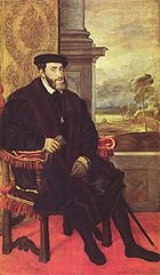
from 1519 and, as Charles I, of the Spanish Empire
from 1516 until his voluntary retirement and abdication
in favor of his younger brother Ferdinand I
and his son Philip II
in 1556.
As the heir of three of Europe's leading dynasties—the House of Habsburg of the Habsburg Monarchy
; the House of Valois-Burgundy
of the Burgundian Netherlands
; and the House of Trastámara of Crown of Castile-León
& Aragon
—he ruled over extensive domains in Central, Western, and Southern Europe; and the Spanish colonies
in North, Central, and South America, the Caribbean, and Asia.
Charles was the eldest son of Philip the Handsome
and Joanna of Castile
.
1516 The Treaty of Noyon between France and Spain is signed. Francis I of France recognises Charles's claim to Naples, and Charles V, Holy Roman Emperor recognises Francis's claim to Milan.
1519 Charles V is elected Emperor of the Holy Roman Empire.
1521 Charles V, Holy Roman Emperor, opens the Diet of Worms.
1521 Martin Luther's first appearance before the Diet of Worms to be examined by the Holy Roman Emperor Charles V and the other estates of the empire.
1521 Battle of Villalar: King Charles I of Spain defeats the Comuneros.
1521 The Diet of Worms ends when Charles V, Holy Roman Emperor, issues the Edict of Worms, declaring Martin Luther an outlaw.
1527 Spanish and German troops sack Rome; some consider this the end of the Renaissance. 147 Swiss Guards, including their commander, die fighting the forces of Charles V in order to allow Pope Clement VII to escape into Castel Sant'Angelo.
1532 Henry VIII and François I sign a secret treaty against Emperor Charles V.
1539 Treaty of Toledo signed by King Francis I of France and Holy Roman Emperor Charles V.
1548 The city of Nuestra Senora de La Paz (Our Lady of Peace) was founded by Captain Alonso de Mendoza by appointment of the king of Spain and Holy Roman Emperor, Charles V.

